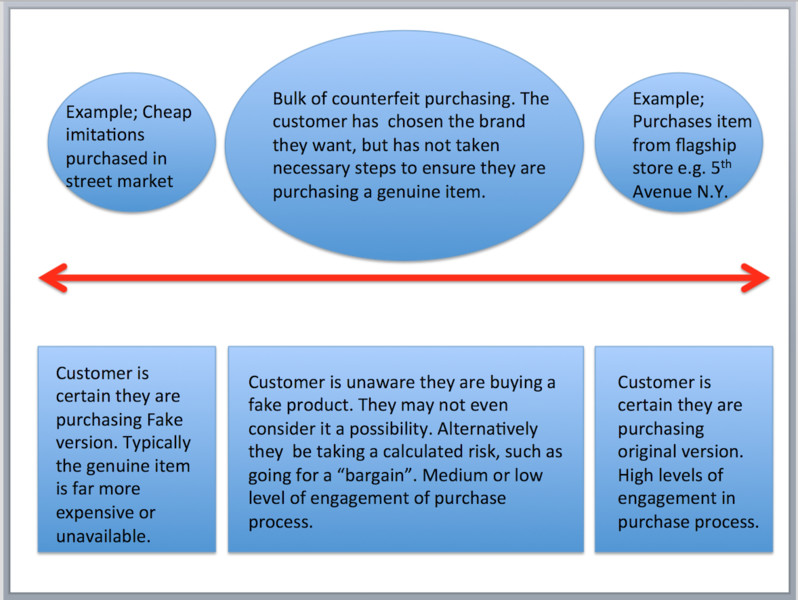|
|
|||||||||||
|
Can brands persuade customers to take care not to buy counterfeits?
|
|||||||||||

|
|||||||||||
|
As a follow-on to my recent post, and in response to a useful comment posted in response, I thought I would elaborate on my assertion that most counterfeit purchases have in common a lack of care by the purchaser. There are degrees of lack of care ranging from complete unawareness of any risk (being care-free) to making a judgement call that it will probably be ok (not the end of the world), to knowingly choosing a fake (the genuine item is out of reach either physically or financially). My basic visual above aims to simply classify purchasing decisions in the relation to counterfeits. Connected with this are the marketing 5Ps (probably now up 7 or more for modern marketeers!) which ultimately drive a brand's sales; Product Place Price Promotion The huge opportunity for counterfeiters arises often because brand owners spend vast budgets making the consumer care about the "Product". Usually this is by clever "Promotion" such as traditional advertising. However, there are not many brands that go to great efforts to make the customer care about the "Place" i.e. where they buy the item from. When we buy a very high ticket item we tend to do a great deal of due diligence and research to ensure we are getting what we pay for. Many of us are taught "Buyer Beware!" at an early age. However, as the ticket price of the item we are buying decreases there is a degree of abandonment of care from this. We tend to disengage from various "P"s until sometimes we are buying on just one or two of the "P"s. We even do this for some high ticket items, such as car insurance, if we see it as a chore. We buy various low ticket items from a convenience store because of its handy Place, although it might be more expensive than if we shopped around and went the extra distance to a supermarket. Online, price comparison sites flourish because there are large numbers of buyers shopping primarily on Price. The issue of the customer being unaware of the risk of purchasing a fake (the middle area of the arrow) is almost certainly the most important one with regards to the size of problem. They currently do not care enough about the "Place" component of the purchase as they do not see why they should. There is often a lack of awareness about the prevalence of fake goods in certain contexts. Perhaps the opportunity for companies here is to learn from counterfeiters and approach the 5Ps in a way counterfeiters can not compete on. This encourages as many buyers to shift their purchasing habits significantly to the right hand side of the red arrow above. IP enforcement and brand protection are crucial components in helping with this process of doing as much as possible to reduce criminality, protect public safety and protect innovation. In various instances, IP protection also extends into doing as much as possible to increase awareness in their customers. However, it is rare that these initiatives dove-tail with the companies' core marketing. I don't know the answer for all companies but could brand protection functions, product development, sales and marketing functions do more to coordinate efforts to push buyers to the right of the arrow? Counterfeiters are criminals and should be tackled as such, but they also represent competitors for market share which, given the scale of the problem, potentially justifies a more joined-up approach for brand owners. This is easier for founders as they are often involved closely with all company functions. With very large companies this is much more difficult. It also can mean taking risks, which aren't necessarily always encouraged in all corporate structures. The issue of counterfeits is still treated quite secretively by many companies. Brand owners themselves are aware of the recourse to the buyer of receiving fake versions of their products. This can include severe health risks but also more mundane points such has having no warrantee or after-sale support. Often after receiving a counterfeit product, a customer becomes quickly educated about the downsides of not ensuring they were buying a genuine item. In other cases, the buyer may never be aware they have a counterfeit but that item may be detrimental in an unseen way such as toxicity. Whilst I appreciate it is not easy, could this type of information be made more available to customers prior to their purchase, woven into the desirability of the brand? My own shopping habits have changed since becoming more aware about the counterfeit issue. I now take much greater care on the "Place". I have therefore shifted my behaviour so that my purchasing is further towards the right hand side of the red line. I care more about this aspect of the purchasing process than I did previously, and as such I am less likely to be hood-winked into buying fakes. In my case this was brought about by the nature of my work. Many of the worlds most successful brands achieve extremely high levels of engagement with their customers. In doing so, they make it much harder for counterfeiters to compete for their customers. However, even within this group there will always be opportunities to learn why some customers are being lost to counterfeiters. |
|||||||||||
|
|
|||||||||||
|
|
|
|
|
|
|
|
|||||

